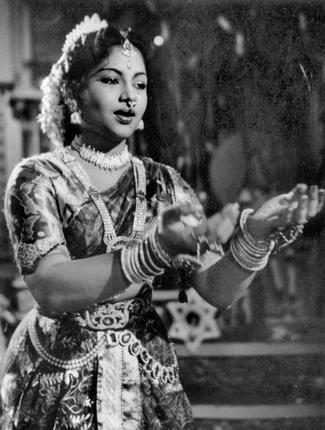Rajasulochana
Title and authorship of the original article(s)
|
Veteran actress Rajasulochana By IANS, Mar 5, 2013/ The Hindu |
This is a newspaper article selected for the excellence of its content. |
CHENNAI: Veteran southern actress and dancer Rajasulochana breathed her last at her residence here on Tuesday morning. She was 77 and is survived by two daughters.
"She was suffering from breathing problems over the last few days and passed away this morning in her sleep," said a family member.
In 1953, Rajasulochana made her cinematic debut with Kannada film "Gunasagari". She has acted in approximately over 250 films across Tamil, Telugu and Kannada.
She founded "Pushpanjali Nritya Kala Kendram", a dance school, in 1961 here.
Some of her best films include "Babruvahana", "Sri Kalahasti Mahatyam" and "Todi Kodallu". She was married to Telugu director C.S Rao.
The Hindu's tribute
One of the most successful stars in Tamil, Telugu, Hindi, Kannada and Malayalam movies, Pilliarchetty Bhakthavatsalam Naidu Rajeevalochana (her original name) born August 15, 1934, passed away in her home in Madipakkam in Chennai, during the early hours of March 5. Thanks to her father being promoted as PA to the General Manager of M&SM Railway the family moved to Madras from Vijayawada and settled in Triplicane, where she went to school. The school authorities recorded her name as Rajasulochana, and that’s how she continued to be known….
As a young girl, she showed interest in classical dance and had her early lessons at Saraswathi Gana Nilayam in Triplicane; her first guru was Lalithamma who taught her Bharatanatyam. Later, she learnt from K.N. Dandayudhapani Pillai (Bharathanatyam), Acharyulu and Vempati Chinna Satyam (Kuchipudi), Krishnakumar and Vishnu Vysarkar (Kathak) and Kalamandalam Madhavan (Kathakali).
Those were the days when middle-class families did not encourage girls to perform on stage, and, much against convention, Rajasulochana had her arangetram in Madras, which was presided over by the famed music scholar, lawyer and judge of the Madras High Court and Supreme Court of India, T.L. Venkatarama Iyer.
Not surprisingly, movies beckoned her, and she took her bow thanks to the celebrated Kannada stage and screen maestro H.L.N. Simha. Gunasagari (Sathyasodhanai in Tamil), produced by the Kannada cult figure Gubbi Veeranna, marked her screen debut.
She entered Tamil cinema in the early 1950s with Pennarasi, a costume drama produced by M. A. Venu, written by A.P. Nagarajan and directed by K. Somu. It was made at the famous Central Studios, Coimbatore. Her songs and dances drew enormous attention, and her fame spread far and wide.
Rajasulochana has acted in hundreds of films in many languages. Though it is not possible to list all of them, mention must be made of some that created history. Not many are aware that she was cast as the heroine in the cult film Parasakthi. But she had to opt out of the film because of her pregnancy. It was only then that Telugu actress Sriranjani Jr. was brought on board.
Rajasulochana’s most successful film, according to critics and moviegoers, was Thai Pirandhaal Vazhi Pirakkum with S.S. Rajendran, written, produced and directed by the Tamil scholar-turned- filmmaker A.K. Velan. A raving success, the film had melodious music by K.V. Mahadevan. Many songs such as ‘Amudhum thenum etharku nee aruginil irukkayiley’ became hits and are still remembered. It was remade in Telugu as Manchi Manasuku Manchi Rojulu with N.T. Rama Rao playing the lead. The film was directed by her husband, noted writer-director C.S. Rao.
Rajasulochana had the privilege of acting with all the superstars of South Indian cinema such as M.G. Ramachandran, Sivaji Ganesan, N.T. Rama Rao, Akkineni Nageswara Rao, Rajkumar, S.S. Rajendran, A.P. Nagarajan and M.N. Nambiar.
Her other films worth mentioning are Gulebakavali, Vanangamudi, Nallavan Vaazhvaan, Mangalyam, Rangoon Radha, Pennarasi, Kavalai Illaadha Manithan and Ellam Inba Mayam (all Tamil); Pellinati Pramanalu, Raja Makutam, Jayabheri, Santhinivasam, Mahakavi Kalidasu, Iddaru Mitrulu, Tiger Ramudu, Valmiki and Thatha Manavudu (a super hit and the debut of ace filmmaker Dasari Narayana Rao) (all Telugu); Bedara Kannappa, Valmiki (Kannada); Chori Chori (Hindi, a Raj Kapoor-Nargis-AVM movie she was cast with Bhagwan); and Manasakshi (Malayalam).
In the movies she starred in, she spoke the dialogues herself. This is an interesting feature, especially today, when actors hardly speak in their own voices. Her only regret was she did not receive a college education.
One of her twin daughters, Devi, who lives in Chennai, is a talented dancer. Her other daughter, son and grandchildren live in the United States.
A recipient of many awards, Rajasulochana founded her dance school ‘Pushpanjali Nritya Kala Kendram’ in 1961 in Chennai, which celebrated its silver jubilee in 1986.
A good friend of this writer for over three decades, she was warm, friendly and humble with no starry airs. The artiste is gone but her movies shall live forever...life is short but art is immortal ….
